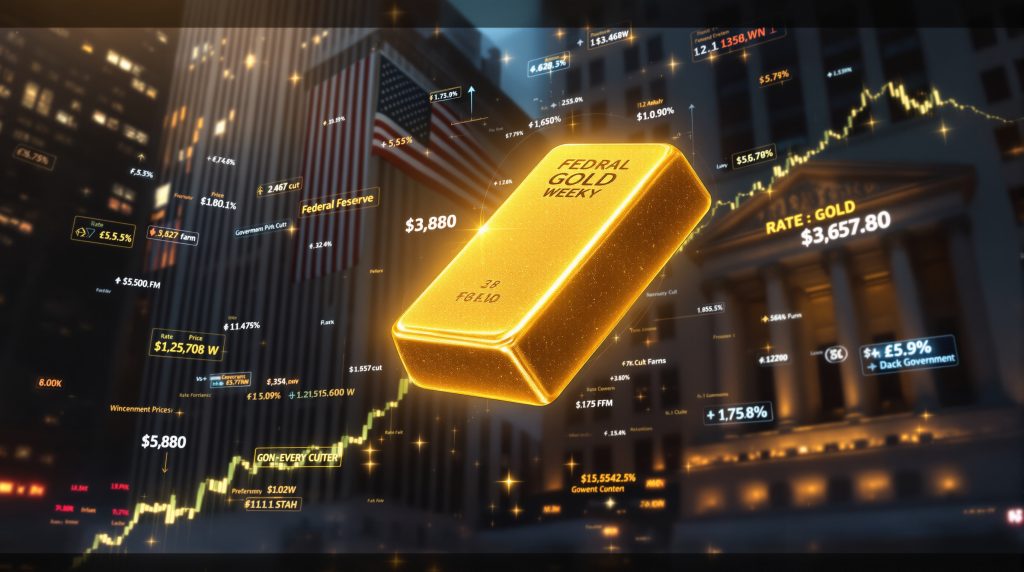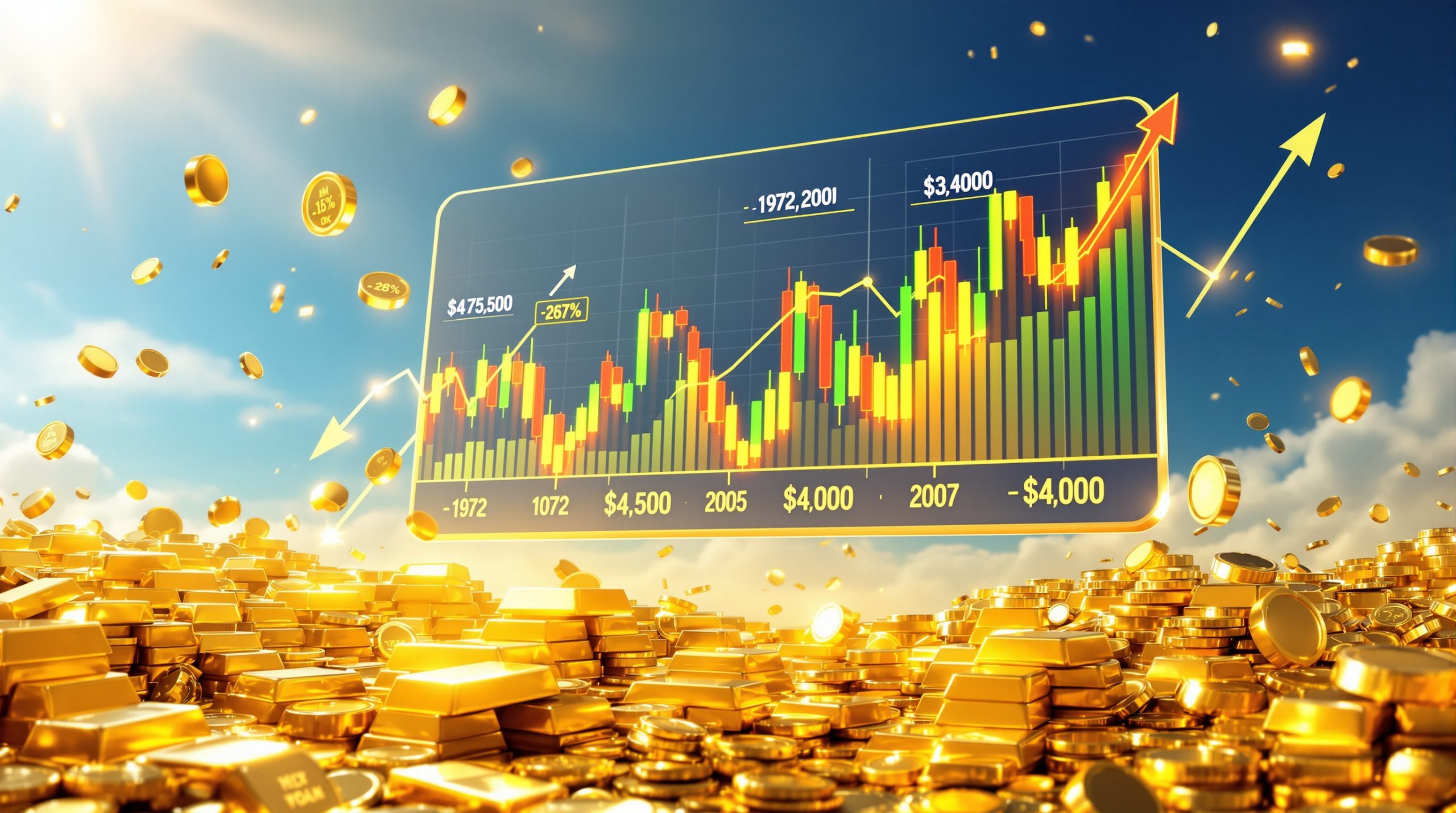Gold Set for Seventh Weekly Gain as US Shutdown Clouds Federal Reserve Rate Path
Gold continues its impressive march upward, heading toward a seventh consecutive weekly gain as the ongoing US government shutdown introduces another layer of uncertainty for investors trying to anticipate the Federal Reserve's monetary policy decisions. With gold price highs analysis showing prices soaring above $3,880 per ounce, the precious metal has demonstrated remarkable resilience despite technical indicators suggesting overbought conditions for more than a month.
Impact of Government Shutdown on Economic Data
The US government shutdown has created significant data disruption, most notably delaying the publication of the crucial monthly payroll report. This information vacuum has forced market participants to rely heavily on private sector economic indicators as primary reference points for gauging economic health.
Fed Bank of Chicago President Austan Goolsbee acknowledged this challenge, noting that the data blackout makes it considerably more difficult for central bankers to interpret the economy's direction accurately. This uncertainty creates an environment where gold safe‐haven insights typically reveal that such assets thrive.
Recent economic indicators have added to market concerns. The Institute for Supply Management's services index showed concerning developments in September, with business activity contracting for the first time since the pandemic while new orders barely expanded. These signs of economic weakness further complicate the Fed's decision-making process.
Gold's Record-Breaking Performance in 2025
Gold has delivered extraordinary performance in 2025, surging approximately 48% year-to-date and setting the stage for its strongest annual gain since 1979. This remarkable gold market surge has established successive all-time highs throughout the year, with prices now just shy of the psychologically significant $4,000 threshold.
Several key factors have fueled this impressive performance:
- The Federal Reserve's pivot to interest rate cuts
- Substantial central bank purchasing programs worldwide
- Increasing investor inflows into gold-backed exchange-traded funds
- Heightened safe-haven demand amid geopolitical uncertainties
- Strong technical momentum attracting additional investment capital
The precious metal's performance has been particularly notable across different timeframes:
| Time Period | Price Level | Percentage Gain |
|---|---|---|
| January 2025 | ~$2,630/oz | Baseline |
| Q1 2025 | ~$2,850/oz | +8.4% |
| Q2 2025 | ~$3,200/oz | +21.7% |
| Q3 2025 | ~$3,600/oz | +36.9% |
| October 2025 | ~$3,880/oz | +47.5% |
Industry analysts highlight that gold's seven consecutive weeks of gains represent the longest sustained rally since 2020, showcasing remarkable resilience despite technical indicators suggesting overbought conditions for more than a month.
Federal Reserve Rate Cut Expectations
Financial markets continue to price in high probabilities for continued monetary easing by the Federal Reserve, with expectations firmly established for a quarter-point interest rate cut at the October meeting, followed by another reduction in December. These anticipated rate cuts provide strong support for non-yielding assets like gold.
The relationship between interest rate expectations and record‐high gold prices follows several established patterns:
- Lower interest rates reduce the opportunity cost of holding non-yielding assets
- Declining real yields enhance gold's relative attractiveness compared to interest-bearing securities
- Forward-looking rate cut expectations are often priced into gold before actual implementation
- Dollar weakness typically accompanying rate cuts benefits gold pricing in USD terms
Current market probabilities reflect strong conviction about the Fed's near-term actions:
- October 2025 meeting: Approximately 95% probability of a 25 basis point cut
- December 2025 meeting: Around 85% probability of an additional 25 basis point cut
- Q1 2026 outlook: Markets pricing in potential pause depending on forthcoming inflation data
Technical Indicators and Gold's Current Rally
Despite gold's impressive performance, several technical indicators suggest the precious metal is trading in significantly overbought territory. The Relative Strength Index (RSI) has remained above 70 for an extended period, traditionally a signal that warns of potential price corrections or consolidation phases.
However, fundamental factors continue to provide underlying support that has thus far prevented major pullbacks:
- Price levels trading significantly above both 50-day and 200-day moving averages
- Bullish momentum indicators maintaining strength despite the extended rally
- Emerging resistance levels near the psychological $4,000/oz threshold
- Recent price action establishing strong support at previous resistance levels
Key technical levels being monitored by market participants include:
| Technical Level | Price Point | Significance |
|---|---|---|
| Immediate Resistance | $3,900/oz | Recent high |
| Psychological Resistance | $4,000/oz | Major round number |
| Near-term Support | $3,800/oz | Recent consolidation area |
| Secondary Support | $3,700/oz | Previous resistance turned support |
Performance of Other Precious Metals
While gold has dominated headlines, other precious metals have also demonstrated strong performance, albeit with different market dynamics and industrial demand factors influencing their price movements.
Silver has been particularly impressive, currently trading around $47.97 per ounce after rising 2.1% in the latest session. Its year-to-date gain of approximately 55% has actually outpaced gold, benefiting from both investment demand and industrial applications. The metal's dual nature as both a precious and industrial metal has supported its performance, with increasing demand from solar panel manufacturing and electronics sectors complementing investment interest.
Platinum and palladium have also shown strength:
- Platinum trading at $1,638.35/oz (up 3.0% in the latest session)
- Palladium at $1,286.25/oz (up 1.4% in the latest session)
These metals face different demand dynamics than gold, with automotive catalyst applications playing a significant role in their price performance. Technological shifts in vehicle manufacturing continue to influence the relative demand between platinum and palladium, creating distinct market conditions compared to more investment-focused gold.
Expert Forecasts Through Year-End 2025
Market analysts have been consistently revising their gold price forecast upward throughout 2025, with many now projecting continued strength through year-end and into 2026. However, opinions differ regarding the sustainability of the current rally and the potential for near-term corrections.
Major investment banks have updated their year-end targets to between $3,800 and $4,200 per ounce, reflecting the strong fundamental backdrop. Technical analysts acknowledge the potential for a pullback before the uptrend resumes, while long-term forecasts suggest structural support for elevated gold prices will persist.
Several key variables will influence future price direction:
- Duration and severity of the US government shutdown
- Pace and magnitude of Federal Reserve rate cuts
- Inflation trajectory across major economies
- Geopolitical developments and broader risk sentiment
- Central bank purchasing patterns in coming quarters
Strategic Investment Approaches for Gold
With gold prices at historic highs and showing signs of potential overextension, investors face important strategic decisions regarding portfolio allocation to precious metals. Different approaches may be appropriate depending on investment timeframes and objectives.
Strategic considerations for investors include:
- Balancing portfolio diversification benefits against concentration risks
- Implementing dollar-cost averaging strategies to mitigate timing risks in volatile markets
- Evaluating the merits of physical gold versus ETF or mining stock exposure
- Assessing gold allocation alongside other potential inflation hedges
Risk management approaches that merit consideration include:
- Establishing target allocations based on overall portfolio strategy and risk tolerance
- Implementing appropriate stop-loss orders for trading positions
- Considering options strategies to hedge downside risks during periods of heightened volatility
- Evaluating correlation patterns with other assets during portfolio construction
Historical Context for the Current Gold Rally
The current gold market shows similarities to several historical periods of strong performance, though each rally has occurred under different macroeconomic conditions. Understanding these historical contexts provides valuable perspective on potential outcomes.
Notable historical gold rallies include:
- 1979-1980: Gold surged over 120% amid high inflation and significant geopolitical tensions
- 2008-2011: The financial crisis and subsequent quantitative easing drove a 170% increase
- 2019-2020: Pandemic uncertainty and monetary stimulus pushed prices up approximately 40%
- 2025: Current rally driven primarily by rate cuts, central bank buying, and economic uncertainty
Comparative analysis of these rallies reveals important distinctions:
| Time Period | Primary Drivers | Duration | Magnitude | Aftermath |
|---|---|---|---|---|
| 1979-1980 | Inflation, Iran crisis | 12 months | +120% | Sharp correction |
| 2008-2011 | Financial crisis, QE | 36 months | +170% | Multi-year bear market |
| 2019-2020 | Pandemic, stimulus | 18 months | +40% | Consolidation |
| 2025 | Rate cuts, central bank buying | Ongoing | +48% YTD | To be determined |
According to Bloomberg's latest analysis, the gold set for seventh weekly gain as US shutdown clouds rate path is creating unprecedented market conditions that few analysts predicted at the beginning of the year.
Common Questions About Gold and Economic Uncertainty
Is gold overvalued at current price levels?
While technical indicators suggest gold is overbought in the short term, fundamental factors including real interest rates, central bank demand, and economic uncertainty continue to provide substantial support. Valuations should be considered relative to other asset classes and within the context of portfolio diversification rather than in absolute terms.
How does the government shutdown impact gold beyond delaying economic data?
Beyond data disruption, the shutdown creates broader economic uncertainty, potentially affects government debt dynamics, and may influence Federal Reserve policy decisions. These factors collectively increase market volatility and risk perception, typically benefiting safe-haven assets like gold.
What role do central banks play in the current gold market?
Central banks globally have maintained strong net buying positions for several consecutive quarters, adding significant demand pressure to the market. This institutional buying represents a structural shift in reserve management practices and provides underlying support for prices independent of investment demand.
How might gold respond if the US government shutdown is resolved quickly?
A swift resolution could temporarily reduce gold's safe-haven premium, potentially triggering profit-taking among short-term traders. However, the impact would likely be moderated by other supportive factors, including anticipated Federal Reserve rate cuts and ongoing central bank purchases.
What correlation exists between gold and other financial markets currently?
Gold has demonstrated negative correlation with both the US dollar and Treasury yields, while correlation with equity markets has been inconsistent. During periods of significant market stress, gold can temporarily correlate with risk assets as investors liquidate positions across all asset classes before reestablishing its traditional safe-haven characteristics.
Key Factors to Monitor
Investors interested in the gold market should closely track several critical indicators in the coming months:
- Federal Reserve communications regarding future rate decisions
- Private sector economic data during the government shutdown period
- Resumption of official economic statistics once the shutdown ends
- Changes in ETF holdings as indicators of investment demand
- Central bank gold purchase volumes in quarterly reports
- Dollar index movements and their impact on gold pricing
- Developments in global geopolitical tensions
- Inflation readings across major economies
The interplay between these factors will likely determine whether gold's remarkable rally continues through the remainder of 2025 or whether a period of consolidation develops as markets digest recent gains. As CNBC recently reported, market participants remain highly attentive to shutdown developments and their potential implications for monetary policy.
Ready to Stay Ahead of the Next Gold Market Move?
Don't miss critical insights on gold price movements and market opportunities with Discovery Alert's proprietary Discovery IQ model, delivering instant notifications on significant ASX mineral discoveries that could affect your portfolio. Visit the Discovery Alert discoveries page to understand how major mineral discoveries have generated substantial returns for early investors.




